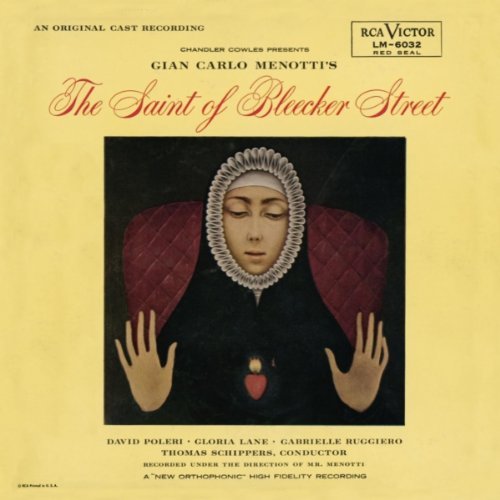The Saint of Bleecker Street, Gian Carlo Menotti’s penultimate Broadway opera, ran for only 92 performances at the Broadway Theater in 1955. However, the piece garnered enough attention to win the Pulitzer Prize for Music and the New York Drama Critics Circle Award for Best Musical. Set in 1954 Little Italy, the devout but sickly Annina sees visions and suffers the stigmata and neighbors flock her to her sick room thinking she can heal them. Annina, aware that her time is limited, wants only to take the veil, but is met with opposition from her atheist brother Michele, who feels that her visions are hallucinations and that the Church is exploiting her. Emotions run high, and this being Menotti, it doesn’t end well for anyone. The cast consists mostly of unknown performers, but the two leads (Gabrielle Ruggiero and David Poleri) are outstanding, offering passionate performances and some truly glorious singing. Gloria Lane (the Secretary in Menotti’s The Consul) is also briefly on hand as Michele’s ill-fated lover, Desideria. Broadway baritones John Reardon and Reid Shelton were also in the cast. This is the first digital release of this particular album, and makes a great case for re-exploration by opera companies.
Not quite so ready for re-exploration, but a fascinating curio nonetheless, is the off-Broadway production of Half-Past Wednesday, a musical adaptation of Grimm’s Rumpelstiltskin. The show, which played 2 performances in 1962 at the Orpheum Theatre, was recorded by Columbia Records. Dom DeLuise leads the cast of five as the King, with Sean Garrison as the Prince, Audre Johnston as Erelda, Robert Fitch as Grandfather and David Winters (an impish delight) as Rumpelstiltskin. The album plays less like a cast album and more like a children’s recording, the kind that used to include a companion book. Much of the dialogue is included to give the album a sense of story, which is especially unusual for Columbia albums of the era (this was produced by Clifford Snyder, not Goddard Lieberson). The songs, by Robert Corley and Nina Jones, are more notable for their clever lyrics than melodies. DeLuise and Fitch get a fun number in “Grandfathers (Ev’ry Baby’s Best Friend).” The album has been pulled from obscurity and is available for the first time since a 1966 reissue. I think it’s telling that in all three issues of the album, Half-Past Wednesday is overshadowed by the big block letters which state “THE NEW MUSICAL VERSION OF RUMPELSTILTSKIN.” It’s better than its two performance run would indicate, especially for the kids.
When most Broadway shows celebrate an anniversary, there is usually a cake and a photo op. Sometimes even a party. However, when the original production of Hair turned 3, the company celebrated the anniversary with an Episcopalian Eucharist at the Cathedral of St. John the Divine on May 9, 1971. (The first two anniversaries had been major celebrations in Central Park). Galt McDermot, Hair’s composer, wrote a Mass which was sung by the Cathedral choir. In place of hymns, songs from the score of Hair were interpolated into the afternoon’s service sung by current cast members. Divine Hair/Mass in F is a live recording of excerpts from the festivities, which includes a chance to hear the Dionne of future Tony-winner Delores Hall. Also among this replacement cast were Allan Nicholls and Dale Soules. It’s a unique experience, as the album includes the welcome from Reverend Canon Edward N. West (who would have made a terrific Starkeeper in Carousel), as well as The Collect, The Epistle and the Gospel (each read by a different priest, one of whom is Gerome Ragni’s brother). There’s also something highly entertaining hearing organist Jack W. Jones perform variations of “Aquarius” on the cathedral’s mammoth pipe organ. It’s not an aurally polished recording, but it presents parts of the Mass in F and songs from Hair in an unusual and fascinating setting. Reverend West provided the original liner notes, which make for a fascinating read.
